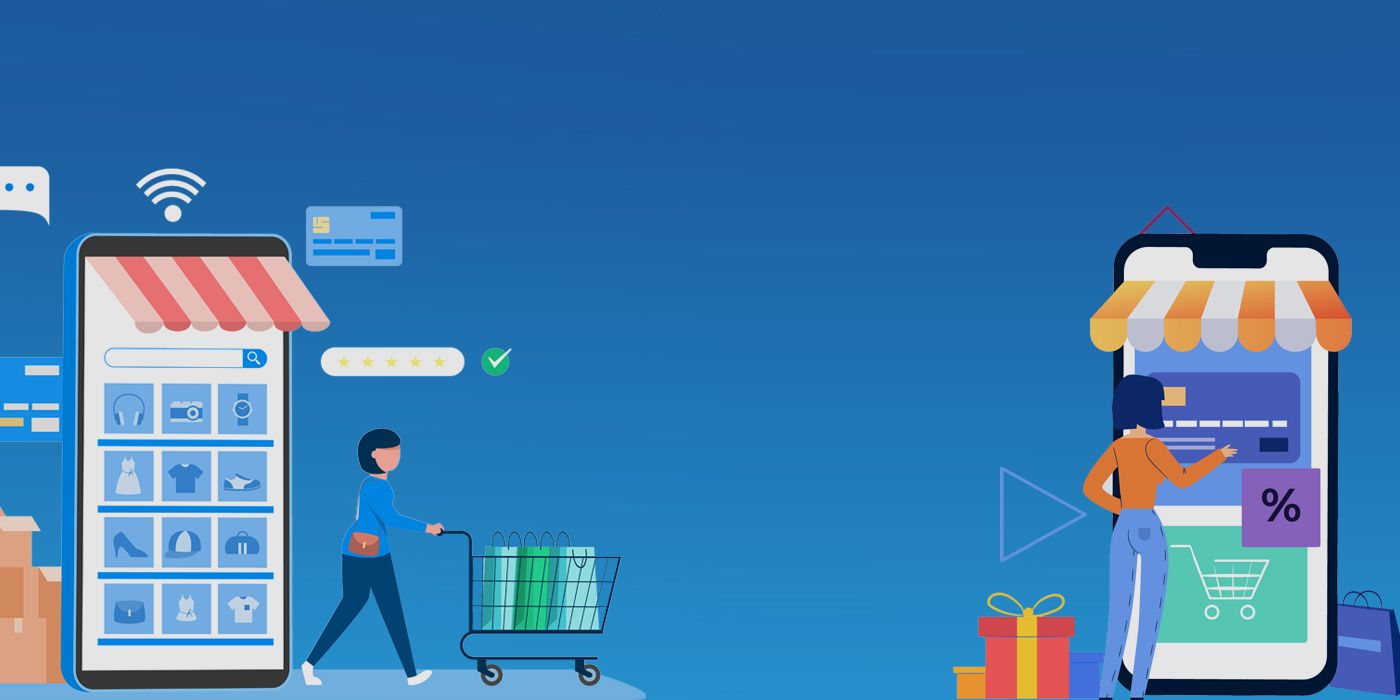Smartphones are an integral part of our lives, and they are slowly taking up a big chunk of our buying habits. Whether comparing prices, reading reviews, locating nearby physical stores or making a purchase…smartphones are everywhere. Mobile e-commerce has become synonymous with convenience. In this infographic, we have shared all the latest trends, updates and predictions for mobile e-commerce that will shape the future.

Mobile eCommerce Statistics and Trends You Cannot Afford to Miss in 2025
Smartphones have become part and parcel of our lives. 6.4 billion people worldwide check inboxes, have video calls, scroll through the feed, and chat on social media with their phones every day. With the advancement in smartphone features, they find it simpler than ever to buy their desired products online.
Mobile eCommerce is fun, convenient, and time-saving for customers; many brands are investing in it today to grow their businesses. This post discusses what it is, why you should use it for your online business, gripping statistics, and the newest trends to follow in 2025.
Let’s dive in.
What is Mobile eCommerce?
Mobile eCommerce uses handheld devices and technologies to browse products and place orders in online stores. Besides shopping, mobile eCommerce helps in online banking, billing, and paying for different services. It also allows you in personalized customer interactions.
As the users can leverage AI integration, push notifications, single-click checkouts, and different payment options, they tend to repeat purchases. Mobile eCommerce serves as an additional marketing channel. When you offer free shipping, affordable product prices, and attractive promo codes, coupons, and offers, your mobile app gets viral and extends your customer base.
Now, let’s discuss why you need mobile eCommerce to grow your business.
Why Should You Use Mobile eCommerce for Your Online Business?
Here are the key reasons to upgrade from an eCommerce website to mobile eCommerce:
Boost Revenues
With the consistent increase in mobile eCommerce sales, mainly amidst the Covid19 pandemic, the mobile online shopping platform is here to stay because of customized push notifications, simple online transactions, and a fast checkout process.
To meet the growing customer demand, boost revenues, and stay ahead of your competitors, you should build a feature-rich mobile app.
Personalized CX
Push notifications, intuitive navigation, and social media incorporation help attract and retain your target customers. With a robust and user-friendly app, you can offer a personalized CX and a seamless buyer journey.
Clear Insights
Analytics give you detailed insights into user browsing history, buying behavior, and patterns. You can use this data to retain more customers by providing personalized and unique offers such as “recommended products” and “segmented promotions.”
Advanced mobile analytics help you reach out to your potential customers with relevant offers and increase the chance of conversions.
Additional Marketing Opportunities
A mobile ecommerce app gives you the chance to directly reach target customers and integrate your offerings with social media profiles. You can promote your products, advertise your brand consistently and encourage people to post comments and share opinions.
Once your mobile app grows extremely popular among customers, you can make a lot of money by posting in-app advertisements.
Key Mobile eCommerce Statistics You Need to Know
Here are some of the thrilling statistics that you need to know for understanding the value of mobile eCommerce in online business:
- By 2025, the number of mobile shoppers in the US is expected to cross 187 million.
- Approximately 40% of all eCommerce purchases in the 2018 holiday season were done through a smartphone.
- 80% of shoppers used their mobile phones inside a physical store to check product reviews, compare their prices and find other store locations.
- The worldwide share of m-commerce in e-commerce has increased to9%
- North America and Europe are expected to be the top countries in the mCommerce market between 2020 and 2025.
- The international id identifier for the coupon industry is expected to grow by55% in 2025.
- By 2025, voice commerce sales may generate approximately $7.4 trillion in revenues.
- 54%of users look for new products and services via social media.
- 83%of users use a specific shopping app on their smartphones when shopping inside a store.
- By 2025, mobile ecommerce sales will make up 10% of the total retail sales in the US.
- 43%of smartphone users rated online purchases as their primary activity.
- By 2025, the number of shoppers in the US is expected to reach187 million
- 67%of customers downloaded a retailer app.
- Mobile is the most robust search platform as 48% of customers use a smartphone to initiate a search engine.
- 68%of the target customers will not submit a form if the seller asks too much personal details.
- 55% of customers have purchased a product online after finding it on social media.
- 70%of mobile searches lead to positive action in an hour.
- 2 billion users spent 234 minutes in 2021 on mobile ecommerce.
- Over 290 million US consumers own smartphones
- By 2022, voice shopping will reach $40
- By 2022, 120000 stores will use Augmented Reality(AR).
- In the second quarter of 2020, 31% of the total ecommerce spend was made on mobile devices.
The statistics above reflect the dominance of mobile eCommerce in the world. But before adopting to grow your online business, you should stay updated with the latest trends.
The Latest Mobile ECommerce Trends to Follow
Find below what’s trending in the mobile eCommerce industry:
Single Click Ordering
As single-click ordering helps mobile eCommerce apps save customer data in their profiles, they don’t need to re-enter personal details manually. One-click ordering allows customers to select default shipping addresses and payment modes.
The trend of one-click ordering in mobile eCommerce is here to stay as customers would always like to save their time. Due to this, mobile apps have an average cart cancellation rate of 85.6%. This increases your sales as customers tend to get annoyed when you ask them repeatedly to enter their names, addresses, and card credentials every time they buy something in your online store. Due to this, mobile apps have an average cart cancellation rate of 85.6%.
Moreover, an online store never charges customers multiple times if they shop for products repeatedly. The brands group orders together to decrease shipping charges.
AI-Activated Chatbots
AI-powered chatbots are the perfect solution to leverage resources and save 30% cost in offering top-notch customer support. Chatbots can reply 24/7 to customer queries, fix their issues, assist them in finding desired products and then place an order. These can communicate like humans and live up to customer expectations by keeping them engaged and offering them a personalized experience.
An intelligent chatbot helps customers in choosing a product, order them, re-order any previously ordered products, and know the delivery time by chatting.
Voice Search
Many customers don’t like typing to search for their desired products, and they use voice search. As 71% of customers use voice search rather than typing, your online business can flourish if you follow this trend. Voice shopping helps customers use virtual assistants, such as Alexa and Siri, to shop many products online. Customers can place orders when cooking, walking down the road, and waiting for a cab by using their voices.
An increasing number of customers utilize voice commands to search for specific products, add products to carts, place orders, make payments, and then track orders. According to reports, voice shopping is expected to reach $40 billion by 2022. So, if you want to meet the demand of such customers and grow your online business, you should optimize your mobile app for voice searches.
Many stores allow customers to voice search and shop products with Google Assistant and Siri. To activate and access the voice search system, customers only need to say something to their virtual assistant. With this advanced system, customers can easily add products to their shopping carts, apply a promo code, select preferred delivery time, make payments and place an order.
So, you can make the entire shopping process easy for customers by implementing voice search.
Augmented Reality(AR)
Nowadays, AR implementation is not only limited to games. As an online store owner, you can benefit significantly by implementing AR to display your products and offer an interactive user experience. With their mobile phones, users can try as many products as they want before buying something. AR-activated rooms are perfect for customers to try various furniture or customer recommendations. They can ensure an outfit will fit into their bodies.
By 2022, the AR marketplace is expected to generate $15.5 billion in revenues. It has proven to be an excellent tool to deliver a personalized customer experience and evolve the concept of online shopping. For instance, an online eyewear store built a mobile app that helps customers try on a wide variety of glasses without visiting a physical store. Customers can also share their selfies with others before buying a pair of eyeglasses that boosts engagement and attracts more customers.
Thus, you should activate AR in your mobile app to deliver personalized CX, give an edge to your eCommerce website and increase revenues.
Progressive Web Apps(PWA)
PWA is a technology that helps smartphone users to install a website and then access it as an app. PWAs function like native applications and occupy less space on their mobile devices. Users enjoy many benefits such as push notifications, immediate updates, quick loading time, and offline access. Customers can install the app from the website browser and access it via their smartphone’s home screen.
A worldwide famous cafe built a PWA to help customers browse the menu and place orders at any location without a high-speed internet connection. You can build a robust and responsive PWA that functions like a native app to offer customers content-centric animations, nutrition details, and personalized orders. If you add the best features to the app, you can satisfy more customers and make more profits.
The Bottom Line
The statistics and latest trends above reflect that mobile eCommerce is about to grow in 2022 and is here to stay. As customers expect a lot from online stores these days, you should leverage mobile eCommerce to impress smartphone users and meet their evolving needs. As you know the thrilling statistics and trends, you should invest in building robust PWA, AR, and chatbots to make online shopping easier for mobile device users.
Once you build a prosperous and scalable mobile app, customers can enjoy voice searches, chatbot communication, one-click ordering, secure online payments, and other relevant convenience. If you want to take your business to the peak this year, invest in mobile eCommerce with no second thoughts.
Frequently Asked Questions
What percentage of purchases are made on mobile?
Today, over three fourths of every sale made online is done using a mobile device. The model has grown rapidly in the past few years. The figure was about 50% in 2016 and was expected to reach 75% by 2025. According to mobile eCommerce statistics, the early rise was fueled by the pandemic and people’s fascination with the internet.
How many people use mobile for online shopping?
Over three fourths of the global urban mobile users have made a purchase using their mobile device in the past 6 months. This figure is a bit low when we go towards rural areas but is catching up quickly now more than ever.
Why mobile commerce is growing so fast?
As smartphones become more accessible and the internet is no longer a luxury in most countries, people are ditching PCs and using their mobile devices to go online. The rise can also be attributed to the falling price of internet across the globe and the growth of online entertainment industry in the past few years.



























